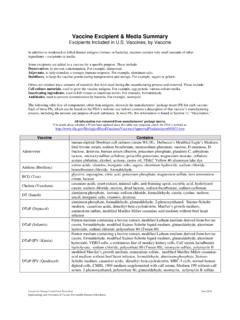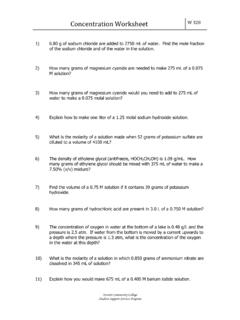Transcription of Technical Data Sheet: Rosemount Magnetic Flow Meter ...
1 Technical Data Sheet 00816-0100-3033 , Rev CC. November 2020. Rosemount Magnetic Flow Meter Material Selection Guide November 2020. Introduction Purpose The purpose of this guide is to provide a general resource for the selection of materials for the Magnetic flowmeter. One of the advantages of the electromagnetic flowmeter is that it is suitable for a wide variety of applications including severely corrosive chemicals and highly abrasive slurries. The key to this versatility is that there is a large choice of materials available for the electrodes and the flowtube liner. Disclaimer Rosemount Inc. neither represents nor warrants the accuracy or sufficiency of the information set forth in this guide for specific end-user applications. Ultimate responsibility for materials selection remains with the end-user. Nothing in this guide constitutes a change to the terms and conditions under which the Rosemount product was sold.
2 The data presented in this guide is based on field experience and published data. However, because of the wide variety of processes and applications it is impossible to guarantee material compatibility in a given process without performing corrosion tests under actual operating conditions. Therefore, the final decision of material resides with the user. Additionally, some of the process fluids listed in this guide do not meet the minimum conductivity requirements for a Magnetic flow Meter . However, they are listed to aid the user in instances where there may be trace amounts contained in the process fluid. Figure 1: Cutaway view of a Magnetic flow Meter A. Liner B. Electrodes Contents 2. Material selection 5. 2 Rosemount Magnetic Flow Meter Material Selection Guide November 2020. How to use this guide Chemical names are listed in alphabetical order.
3 Each chemical may have one or more temperature and concentration combination. In instances where the temperature limit is not given or the compatibility information is left blank, this indicates there is no information available. Flow tube liner Each liner material has two considerations compatibility to the chemical and temperature limit. The following codes define the compatibility with each chemical listed: Compatibility Code Resistant A. Not Resistant N. No Information (Blank). Temperature Limit Code 248 F (120 C) 1. 212 F (100 C) 2. 176 F (80 C) 3. 140 F (60 C) 4. 68 F (20 C) 5. Note Temperature limit values are generally conservative and were chosen to best represent data available. Note that if an A1 code is specified the actual temperature limit of the material may be in excess of 248 F. Electrode material Each electrode material has two considerations corrosion rate per year and temperature limit.
4 The following codes define the compatibility with each chemical listed: Corrosion Rate Per Year Code Less than in. A. Less than in. B. Less than in. C. Greater than in. N. No Information (Blank). Temperature Limit Code 248 F (120 C) 1. 212 F (100 C) 2. 176 F (80 C) 3. 140 F (60 C) 4. 68 F (20 C) 5. 3. November 2020. Note Temperature limit values are generally conservative and were chosen to best represent data available. Note that if an A1 code is specified the actual temperature limit of the material may be in excess of 248 F. References The data found in the Material Selection Guide is based on field experience and data from the follow sources: National Association of Corrosion Engineers (1985) Corrosion Data Survey. Miller, Richard W. (1989) Flow Measurement Engineering Handbook. Schweitzer, Philip A. (1991) Corrosion Resistance Tables.
5 Example This example illustrates how to use the Material Selection Guide to choose compatible flowtube materials for a given process. The example process fluid is 98% sulfuric acid at 100 F (38 C). Liners Electrodes (corrosion rate per year) Temperatures A = Resistant A = Less than inches 1 = 248 F (120 C). N = Not Resistant B = Less than inches 2 = 212 F (100 C). Blank = No information C = Less than inches 3 = 176 F (80 C). Miscellaneous N = Greater than inches 4 = 140 F (60 C). Sat = Saturated Blank = No information 5 = 68 F (20 C). Conc = Concentrated Process liquid Max. Flow tube liner Electrode material conc. PTFE ETFE PFA Poly- Neo- Linatex 316 Ni-Alloy Tanta- Plati- Titan- ure- prene Rubber SST C-276 lum num-20% ium thane Iridium Sulfuric Acid 70% A1 A1 A1 N N A3 B3 N A1 A1 N. Sulfuric Acid 80% A1 A1 A1 N N N B5 A5 A1 A1 N. Sulfuric Acid 90% A1 A1 A1 N N N B5 A4 A1 A1.
6 Sulfuric Acid 95% A1 A1 A1 N N N B3 A1 A1 N. Sulfuric Acid 98% A1 A1 A1 N N N B3 A5 A1 A1. Sulfuric Acid 100% A1 A1 A1 N N N B3 A5 N A1 N. Liner compatibility PTFE resistant up to 248 F (120 C). (from table). ETFE resistant up to 248 F (120 C). PFA resistant up to 248 F (120 C). Polyurethane not resistant Neoprene not resistant Linatex Rubber not resistant 4 Rosemount Magnetic Flow Meter Material Selection Guide November 2020. Electrode 316 SST Corrosion rate of less than in. per year, up to 176 F (80 C). compatibility (from table) Ni-Alloy C-276 Corrosion rate of less than in. per year, up to 68 F (20 C). Tantalum Corrosion rate of less than in. per year, up to 248 F (120 C). Platinum 20% Iridium Corrosion rate of less than in. per year, up to 248 F (120 C). Titanium Corrosion rate of greater than in. per year (not recommended). The proper material selection would be a PTFE, ETFE or PFA liner with Platinum 20% Iridium electrodes.
7 Rosemount Inc. does not guarantee the accuracy of this guide. See Disclaimer. Material selection guide Liners: Electrodes (corrosion rate per year): Temperatures: A = Resistant A = Less than inches 1 = 248 F (120 C). N = Not resistant B = Less than inches 2 = 212 F (100 C). Blank = No information C = Less than inches 3 = 176 F (80 C). Miscellaneous: N = Greater than inches 4 = 140 F (60 C). Sat = Saturated Blank = No information 5 = 68 F (20 C). Conc = Concentrated Process liquid Max. Flow tube liner Electrode material conc. PTFE ETFE PFA Poly- Neo- Linatex 316 Ni-Alloy Tanta- Plati- Titan- ure- prene Rubber SST C-276 lum num-20% ium thane Iridium Acetaldehyde 100% A1 A2 A1 N A2 N B4 A4 B5 A5 A1. Acetamide 100% A1 A1 A1 N A3 N B1. Acetic Acid 50% A1 A1 A1 N A4 N B3 A3 A1 A A1. Acetic Acid 75% A1 A2 A1 N A4 N N A1 A1 A A1. Acetic Acid, 100% A1 A2 A1 N N N A1 A1 A1 A A.
8 Glacial Acetic 100% A1 A1 A1 N A5 N B1 A1 A5 A2 A1. Anhydride Acetone 50% A1 A4 A1 N N N B1 A3 A3 A A3. Acetone 100% A1 A4 A1 N N N A1 A4 A1 A3. Acetophenone 100% A1 A1 A1 N N B1 B3 B5 B3. Acetonitrile 100% A1 A4 A1 B4 B5. Acetyl Chloride 100% A1 A4 A1 N N N B1 B5 A2. (dry). Acetylene 100% A1 A1 A1 A3 A5 A1 B3 B5 B5. Acetylene 100% A. Tetrabromide Acetylene 100% A A2. Tetrachloride 5. November 2020. Liners: Electrodes (corrosion rate per year): Temperatures: A = Resistant A = Less than inches 1 = 248 F (120 C). N = Not resistant B = Less than inches 2 = 212 F (100 C). Blank = No information C = Less than inches 3 = 176 F (80 C). Miscellaneous: N = Greater than inches 4 = 140 F (60 C). Sat = Saturated Blank = No information 5 = 68 F (20 C). Conc = Concentrated Process liquid Max. Flow tube liner Electrode material conc. PTFE ETFE PFA Poly- Neo- Linatex 316 Ni-Alloy Tanta- Plati- Titan- ure- prene Rubber SST C-276 lum num-20% ium thane Iridium Acrylonitrile 100% A1 A4 A1 A4 A5 B3 B3 B3 A2 B3.
9 Adipic Acid 100% A1 A1 A1 A4 A5 B3 A3 B3 A1. Alcohol & 100% A A N N A A A A A. Glycerin Alcohol, 2- 100%. Aminoethanol Alcohol, Allyl 100% A1 A3 A1 A5 A5 A1 B1 B1 A2 B3. Alcohol, Amyl 100%. Alcohol, Butyl 100%. Allyl Chloride 100% A1 A3 A1 N N A5 A2. Alum 10% A A N B B A A A. Alum 100% A1 A1 A1 A3 A4 B3 B4 B5 A A3. Alumina 100% A A N N N A A A A. Aluminium 100% A A A N N N A. Fluoride Aluminium 100% A A A B N A A. Hydroxide Aluminum 100% A1. ammonium sulfate Aluminium 100% A A B B A A B. sulfate Aluminum 20% A A A N A N A A A5 B. Chloride Aluminum 100% A1 A1 A1 A5 A3 A4 N A3 B1 A5 N. Chloride Aqueous Aluminum 100% A A N B A A. Chlorohydrate Aluminum Sat A1 A1 A1 N A3 A4 B5 N A5 A5. Fluoride 6 Rosemount Magnetic Flow Meter Material Selection Guide November 2020. Liners: Electrodes (corrosion rate per year): Temperatures: A = Resistant A = Less than inches 1 = 248 F (120 C).
10 N = Not resistant B = Less than inches 2 = 212 F (100 C). Blank = No information C = Less than inches 3 = 176 F (80 C). Miscellaneous: N = Greater than inches 4 = 140 F (60 C). Sat = Saturated Blank = No information 5 = 68 F (20 C). Conc = Concentrated Process liquid Max. Flow tube liner Electrode material conc. PTFE ETFE PFA Poly- Neo- Linatex 316 Ni-Alloy Tanta- Plati- Titan- ure- prene Rubber SST C-276 lum num-20% ium thane Iridium Aluminum 100% A1 A1 A1 A3 A1 B5 A5 B4. Hydroxide Aluminum 100% A1 A1 A1. Oxychloride Aluminum Sat A1 A1 A1 A3 A4 B3 B B5 A A3. Nitrate Aluminum 100% A1 A1 A1 N A3 A4 N B3 A3 A3. Potassium sulfate Aluminum Sat A1 A1 N A3 A4 B3 B3 A1 A2 A3. sulfate Aminosulfonic 100% A A N N A A. Acid Amino Acids 100% A. Ammonia 100% A1 A1 A1 A5 A3 N A1 B1 A1 A1. (Anhydrous). ammonium 50% A A N N B N A A A. Bicarbonate ammonium 100% A1 A1 B4 B5 B3 A2 A3.













